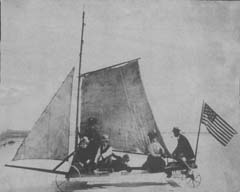Rosamond, Ca. 93560
The Unofficial Website
![]()
Local History - Sailing Rosamond Dry Lake
Today a part of Edwards AFB with public access cut off, Rosamond Dry Lake provided entertainment to pre-aviation Rosamond area residents. The following appeared in the AV Press on Oct. 30, 2007:
"Gliding over the pathless stretches of shifting sand that comprise the dreaded Mojave Desert in Southern California is the queerest craft that ever sailed. Strange tales of a phantom ship that have lately come from that forlorn region, the last place in all the world where a clever modem invention would be looked for, may be traced to this. It is a yacht on wheels, a graceful land‑going clipper, faster than any that ever rode the main, and is aptly named Desert Queen."
Los Angeles writer and photographer John L. Von Blon, in an article in the Strand Magazine, described a wind‑powered wagon made in about 1901 by two brothers, Carl and Charles Hoyt, to sail on Rosamond Dry Lake. The Hoyts, Cleveland natives, worked at Ezra Hamilton's Lida gold mine on Tropico Hill.
The Hoyts told Von Blon their sail wagon had reached 50 mph and they believed it could hit 75 mph, but moving that fast would be dangerous. They had wrecked the sail wagon on its first trial, they said.
Von Blon's article, published in the same English magazine that printed Arthur Conan Doyle's Sherlock Holmes stories, repeats what sound like exaggerations: the sail wagon had traveled 40 miles across the desert in 80 minutes; the Hoyts used it to travel to work every day from their home on the east shore of Rosamond Dry Lake.
Despite Von Blon's prose about gliding across desert sands, there is no indication that the Hoyts' sail wagon ever traveled anywhere but on the dry lake bed, described "as hard as concrete and swept smooth as a tennis court by the sands forever driving over it before the fierce winds rushing through Tehachapi Pass."
The Hoyts told Von Blon the flatness of the lake bed gave them the idea for a wind‑powered wagon, which they built out of odds and ends from around the mining camp.
Von Blon said the Hoyts had built the sail wagon a year before he saw it and photographed it in 1902. In front it had an old buggy axle attached to two 30‑inch‑tall iron wheels off a piece of farm equipment. Smaller iron wheels were at the back, attached to a tiller like those used to steer hook-and‑ladder fire trucks, Von Blon wrote.
Fourteen feet long, the wagon was eight feet across in front and narrower in the rear. Rigged like a sloop, it had a 15‑foot‑tall mast to which were attached a fore‑and‑aft rigged mainsail and jib.
Von Blon suggested building bigger and faster sail wagons ‑ fitted with rubber tires, ball bearings on the axles and bigger sails ‑‑ for traveling the Sahara Desert.
"Several mining capitalists are talking of building two such craft, for racing and for experimental purposes in other directions," Von Blon wrote.
Riding on the Desert Queen was thrilling, according to Von Blon. "You go dodging, at the start, between dots of greasewood and cacti as the 'ship' leaves camp with the rising wind; here and there grotesque yucca trees stand like sentinels, with limbs, like long arms, outstretched to reach you; homed toads scurry away over the hot sands, and lizards dart," Von Blon wrote. "These things you notice at first, but the wind increases and the pace grows madder. You tie a string to your hat and anchor it to your suspender; your handkerchief is whipping from your neck and goes sailing and writhing up and away out of sight almost before you realize that it is gone. This is indeed a different wind from any that ever blew in any other part of the world.”
"You are fairly flying now and but a little sail is up. The air is filled with sand and pebbles as large as buckshot, and they pelt you hard. All around towering spirals of dust ‑ small end of the spiral down ‑ go springing across the plain, whirling up food for the terrible storm that is sweeping from the Sierra Mountains to Death Valley.”
“Wilder becomes the dash of the Queen, and you hang on frantically with both hands and find it hard to catch your breath. The man who steers and the man who hauls in canvas are too busy to see your gasp and shudder."
Compiled by Managing Editor Charles F Bostwick. © AV Press
